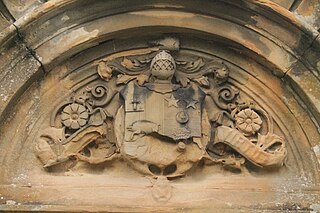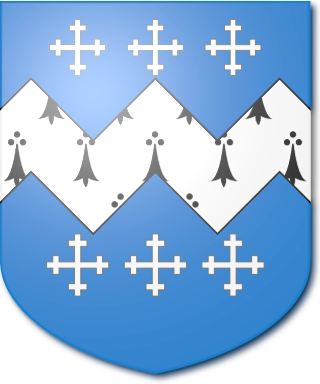Silvester baronets, of Yardley (1815; First creation)

- Sir John Silvester, 1st Baronet (1745–1822)
The Silvester Baronetcy, of Yardley, was a title that was created twice in the Baronetage of the United Kingdom, both times for John Silvester, Recorder of the City of London. The first creation came on 20 May 1815, with normal remainder to the heirs male of his body. The second creation came on 30 March 1822, with remainder in default of male issue of his own to his nephew, Philip Carteret Silvester, son of Rear-Admiral Philip Carteret and Mary-Grace, only sister of Sir John Silvester. The 1815 creation became extinct on Silvester's death in 1822 while he was succeeded in the 1822 creation according to the special remainder by his nephew, the second Baronet. He had earlier the same year assumed by Royal licence the surname of Silvester. This creation became extinct on his death in 1828.



Earl Granville is a title that has been created twice, once in the Peerage of Great Britain and once in the Peerage of the United Kingdom. It is now held by members of the Leveson-Gower family.

Baron Carteret is a title that has been created twice in British history, once in the Peerage of England and once in the Peerage of Great Britain. The first creation came into the Peerage of England in 1681 when the fourteen-year-old Sir George Carteret, 2nd Baronet, was made Baron Carteret, of Hawnes in the County of Bedford. The peerage was originally proposed for his grandfather Sir George Carteret, 1st Baronet, a celebrated royalist statesman, but he died before he was granted the title and as his eldest son, Philip, predeceased him, it was eventually bestowed on his grandson, George, with remainder to the latter's brothers. The Baronetcy, of Metesches in the Island of Jersey, had been created for George Carteret in the Baronetage of England on 9 May 1645. Lord Carteret married Lady Grace Granville, daughter of John Granville, 1st Earl of Bath. In 1715 Lady Grace was raised to the Peerage of Great Britain in her own right as Viscountess Carteret and Countess Granville. Lord Carteret and Lady Granville were both succeeded by their son John Carteret, the second Baron and second Earl. The titles became extinct on the death of the latter's son Robert Carteret, the third Earl, in 1776.
There have been four baronetcies created for persons with the surname Leslie, one in the Baronetage of Nova Scotia, one in the Baronetage of Ireland, one in the Baronetage of Great Britain and one in the Baronetage of the United Kingdom. Three of the creations are extant as of 2010.

There have been four baronetcies created for persons with the surname Baird, two in the Baronetage of Nova Scotia and two in the Baronetage of the United Kingdom.
There have been ten baronetcies created for persons with the surname Mackenzie, seven in the Baronetage of Nova Scotia and three in the Baronetage of the United Kingdom. Four of the creations are extant as of 2010.
There have been five baronetcies created for persons with the surname Vavasour, three in the Baronetage of England and two in the Baronetage of the United Kingdom. As of 2008 four of the creations are extinct while one is extant.
There have been three baronetcies created for persons with the surname Bellingham, one in the Baronetage of England, one in the Baronetage of Ireland and one in the Baronetage of Great Britain. As of 2014 one creation is extant.
There have been six baronetcies created for persons with the surname Brooke, one in the Baronetage of England, one in the Baronetage of Ireland and four in the Baronetage of the United Kingdom. As of 2015 four of the creations are extant, though one has been subsumed into a peerage.

There have been twenty one baronetcies created for persons with the surname Williams, eight in the Baronetage of England, three in the Baronetage of Great Britain and ten in the Baronetage of the United Kingdom. Only six of the creations are extant as of 2017.
There have been three baronetcies created for persons with the surname Oakes, all in the Baronetage of the United Kingdom. Two of the creations were in favour of the same person.
There have been three baronetcies created for persons with the surname Clayton, two in the Baronetage of Great Britain and one in the Baronetage of the United Kingdom. One creation is extant as of 2021.
There have been six baronetcies created for persons with the surname Price, one each in the baronetages of England and of Great Britain and four in the baronetage of the United Kingdom. Two of the creations were extant as of 2008.

There has been six baronetcies created for persons with the surname Shaw, one in the Baronetage of England, one in the Baronetage of Nova Scotia and four in the Baronetage of the United Kingdom. Two of the creations extant as of 2010.

The Tierney Baronetcy, of Brighthelmstone in the County of Sussex and of Dover Street in the County of Middlesex, was a title that was created twice in the Baronetage of the United Kingdom, both times in favour of Matthew John Tierney, Physician-in-Ordinary to George III and George IV. The first creation came on 3 October 1818, with normal remainder to the heirs male of his body. The second creation came on 5 May 1834, with remainder in default of male issue of his own to his younger brother Edward Tierney, Dublin, then crown solicitor for Ireland, and the heirs male of his body. The 1818 creation became extinct on Tierney's death in 1845 while he was succeeded in the 1834 creation according to the special remainder by his brother, the second Baronet.
Sir Philip Carteret Silvester (1777–1828) was a captain in the Royal Navy
There have been five baronetcies created for persons with the surname Taylor, one in the Baronetage of England, one in the Baronetage of Great Britain and three in the Baronetage of the United Kingdom. Only one creation is extant as of 2011.

There have been two baronetcies created for members of the Barnardiston family, both in the Baronetage of England. Both creations are extinct.

Sir John Silvester, 1st Baronet, FRS, FSA, DCL, was an English lawyer and Common Serjeant of London from 1790 to 1803, and Recorder of London from 1803 until his death in 1822.
There have been three baronetcies created for people with the surname Moncreiffe or Moncreiff, two in the Baronetage of Nova Scotia and one in the Baronetage of the United Kingdom. Two of the titles are dormant, as the heir has not proved his descent, and one is extant, though its holder does not bear the surname of Moncreiffe.
Carteret is a surname of Norman origin. It derives from Carteret, Normandy, an inhabited place on the northwest coast of the Cotentin peninsula, facing the Channel Islands. The Channel Islands are the only remnant of the Duchy of Normandy, the original territorial holding of William the Conqueror, who invaded England in 1066. Historically, members of the Carteret family have occupied influential positions in the Channel Islands, notably as hereditary Seigneurs of Sark and hereditary Bailiffs of Jersey.